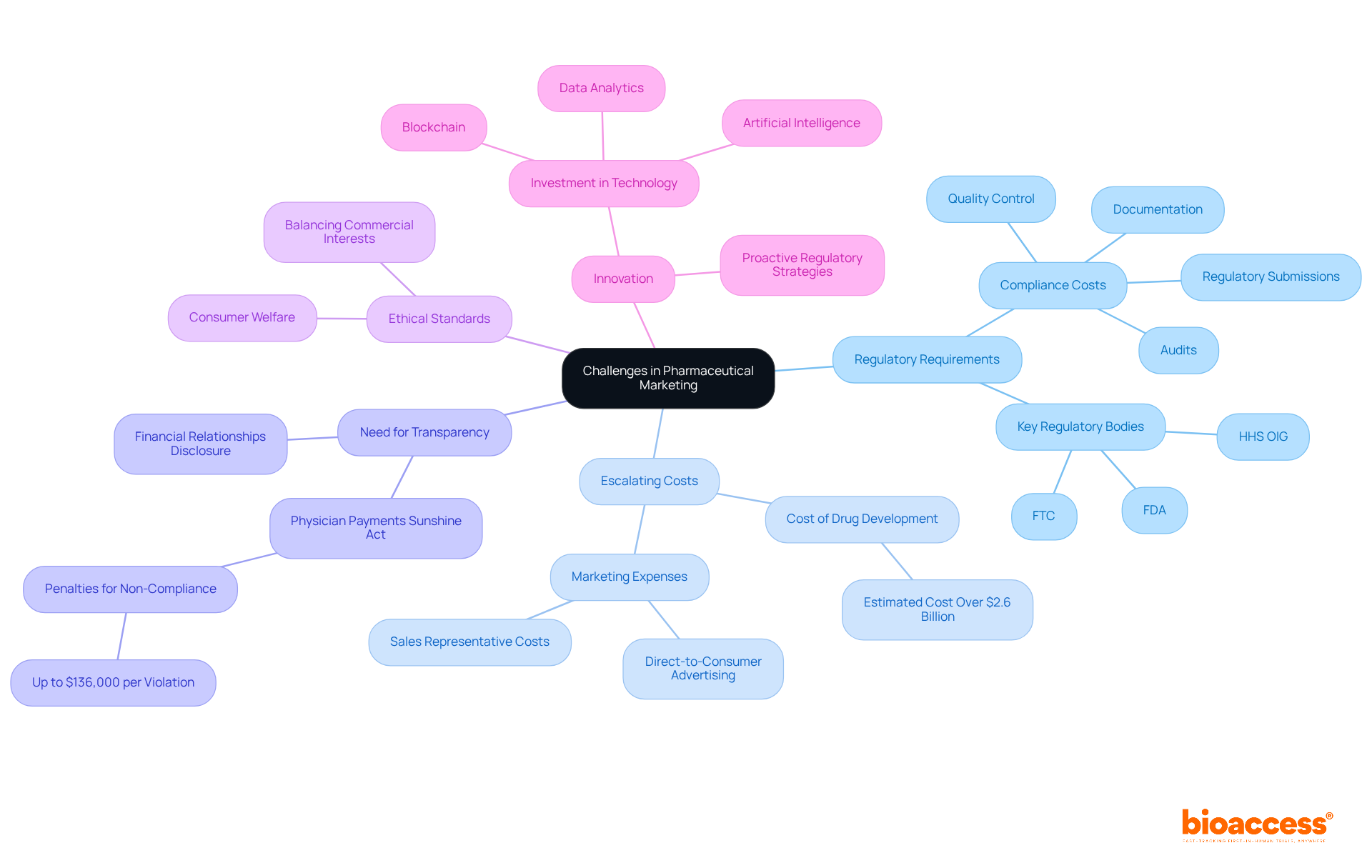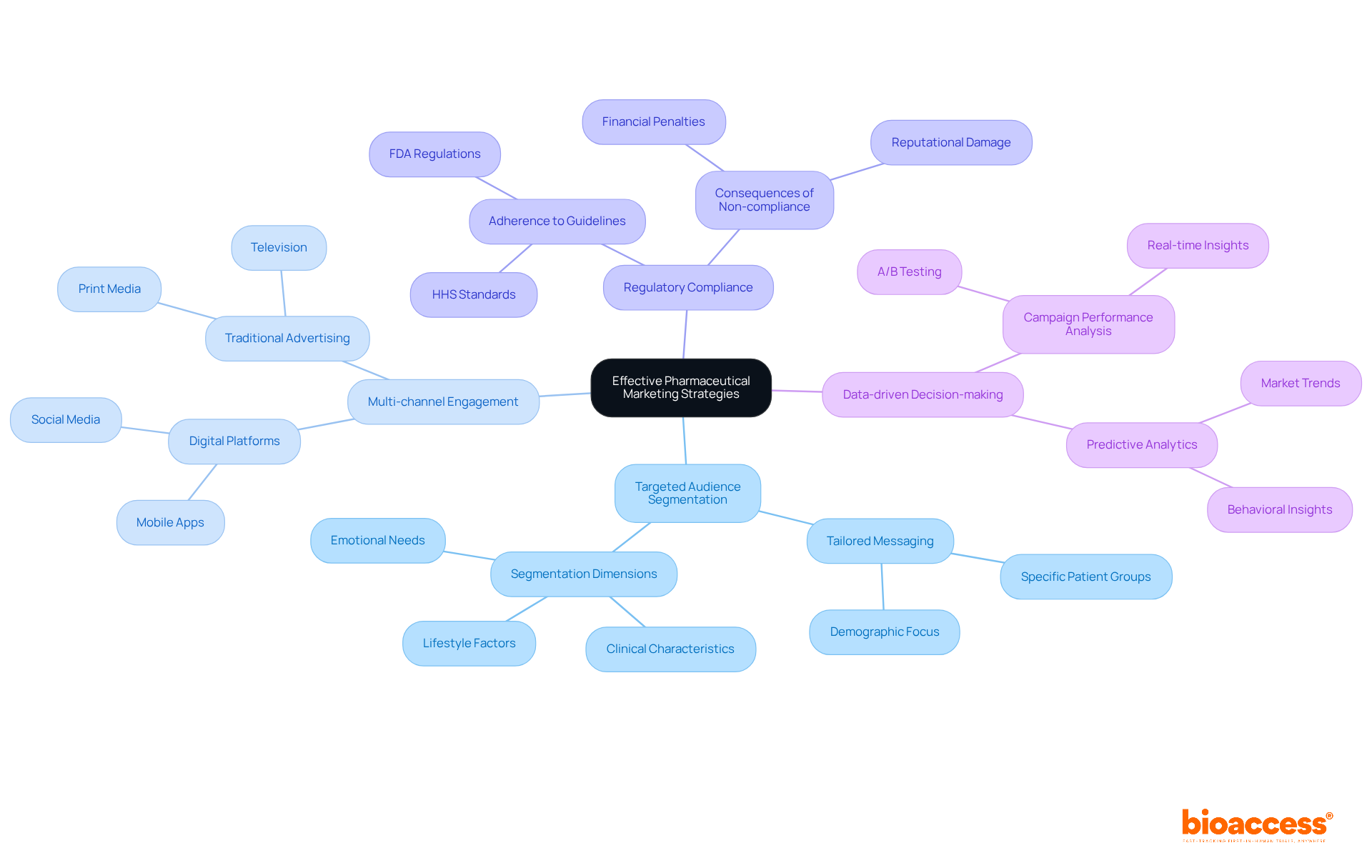


The marketing strategy of pharmaceutical companies is centered on the effective promotion of products to healthcare professionals and consumers, all while adhering to stringent regulatory guidelines. This article underscores essential components such as:
These elements are crucial for navigating the competitive landscape and ensuring compliance, ultimately enhancing patient care and outcomes. By understanding these strategies, stakeholders can better appreciate the complexities involved in pharmaceutical marketing and its impact on healthcare.
The pharmaceutical industry is navigating a complex landscape where marketing strategies must not only promote products but also adhere to rigorous regulatory frameworks. As companies strive to engage healthcare professionals and consumers alike, understanding the intricacies of these marketing tactics becomes essential for success.
What challenges do pharmaceutical companies face in balancing compliance with innovative outreach? How can they leverage emerging trends like patient-centric marketing to enhance their strategies?
Exploring these questions reveals the dynamic nature of pharmaceutical marketing and its critical role in shaping the future of healthcare communication.
The marketing strategy of pharmaceutical company includes the methods and tactics employed by pharmaceutical firms to advertise their products to healthcare professionals and consumers. These strategies are designed to effectively convey the advantages, applications, and safety of medications, all while adhering to stringent regulatory guidelines.
The promotional landscape has undergone significant evolution, integrating digital channels, data analytics, and patient engagement initiatives to enhance outreach and effectiveness. Understanding the marketing strategy of pharmaceutical company is crucial for navigating the competitive pharmaceutical landscape and ensuring compliance with industry regulations. By grasping the nuances of these promotional methods, stakeholders can better position themselves within the market and respond adeptly to the challenges that arise.

Pharmaceutical promotion presents significant challenges, primarily due to stringent regulatory requirements, escalating costs, and the imperative for transparency. Companies must navigate a complex landscape of regulations set forth by key bodies such as the FDA, FTC, and HHS OIG, which govern advertising practices and often constrain promotional activities. For instance, the cost of bringing a new drug to market is estimated to exceed $2.6 billion, largely driven by rising regulatory demands, including direct costs associated with quality control, documentation, audits, and regulatory submissions.
Additionally, the push for personalized marketing necessitates substantial investments in data analytics and technology, further straining budgets. Upholding ethical standards while effectively communicating product advantages poses a significant challenge, as companies strive to balance commercial interests with consumer welfare. This delicate equilibrium is underscored by the Physician Payments Sunshine Act, which mandates transparency in financial relationships between drug manufacturers and healthcare providers, with penalties for non-compliance reaching approximately $136,000 per violation for knowing failures.
To thrive in this environment, drug companies must adopt innovative solutions and demonstrate strategic flexibility in their marketing strategy of pharmaceutical company, ensuring they remain competitive while maintaining high standards of compliance and safety for individuals.

The marketing strategy of pharmaceutical company encompasses several essential components:
Targeted audience segmentation is crucial, enabling companies to tailor their messaging for specific healthcare professionals and demographic groups, thus enhancing relevance and effectiveness. For instance, identifying and reaching distinct patient groups, such as adults with Type 2 diabetes, necessitates tailored messaging that resonates with their unique needs.
Multi-channel engagement is vital for maximizing outreach, integrating digital platforms, social media, and traditional advertising to ensure promotional efforts reach a diverse audience. Research indicates that 72% of consumers and 89% of business purchasers expect brands to understand their needs through various channels, underscoring the importance of a cohesive promotional strategy.
Compliance with regulatory standards is paramount, as pharmaceutical companies navigate stringent guidelines from bodies like the FDA and HHS. Non-compliance can result in severe financial consequences, with fines totaling $33 billion from 2003 to 2016. Therefore, maintaining credibility through adherence to regulations is essential for successful marketing.
Ultimately, leveraging data analytics enables companies to assess campaign performance and refine approaches based on real-time insights. This data-driven strategy not only enhances engagement but also drives better outcomes, as evidenced by case studies demonstrating significant improvements in physician engagement metrics through targeted outreach. By integrating these elements, the marketing strategy of pharmaceutical company allows drug marketers to formulate impactful plans that resonate with their audiences and cultivate enduring relationships.

The pharmaceutical sector is undergoing a significant transition towards consumer-focused promotion, emphasizing the necessity of understanding and addressing the requirements and preferences of individuals. This approach involves engaging individuals in the marketing process and utilizing their feedback to inform product development and communication strategies.
By leveraging digital tools and platforms, companies can craft tailored experiences that resonate with individuals, thereby fostering trust and loyalty. This trend not only enhances individual involvement but also improves treatment adherence and health outcomes.
As the industry continues to evolve, the marketing strategy of pharmaceutical companies is emerging as a cornerstone of successful pharmaceutical strategies, reflecting a broader commitment to enhancing patient care.

The marketing strategies employed by pharmaceutical companies are crucial for effectively promoting their products while navigating a complex regulatory landscape. These strategies, which incorporate digital advancements and patient engagement initiatives, are designed to communicate the benefits and safety of medications to both healthcare professionals and consumers. As the industry evolves, understanding these marketing approaches becomes increasingly vital for stakeholders aiming to remain competitive and compliant.
Key arguments explored in this article highlight the challenges pharmaceutical companies face, including:
Companies must balance commercial interests with ethical standards, all while adopting innovative solutions to enhance their marketing effectiveness. Furthermore, the article emphasizes the importance of:
as critical components of successful pharmaceutical marketing strategies.
In a landscape where patient-centric marketing is gaining prominence, pharmaceutical companies must prioritize understanding the needs and preferences of individuals. By embracing this shift and leveraging digital tools, firms can foster trust and improve health outcomes, ultimately enhancing their market position. As the pharmaceutical industry continues to adapt, the significance of robust marketing strategies cannot be overstated; they are not just a means to promote products but a fundamental aspect of improving patient care and ensuring long-term success in the sector.
What are pharmaceutical marketing strategies?
Pharmaceutical marketing strategies refer to the methods and tactics used by pharmaceutical companies to promote their products to healthcare professionals and consumers, emphasizing the benefits, applications, and safety of medications while following regulatory guidelines.
How has the promotional landscape in pharmaceutical marketing changed?
The promotional landscape has evolved significantly by incorporating digital channels, data analytics, and patient engagement initiatives to improve outreach and effectiveness.
Why is understanding pharmaceutical marketing strategies important?
Understanding these strategies is essential for navigating the competitive pharmaceutical landscape and ensuring compliance with industry regulations, enabling stakeholders to position themselves effectively in the market and address challenges.